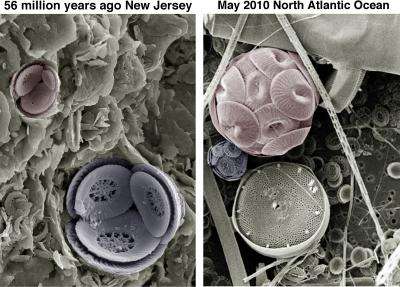Climate change clues from tiny marine algae—ancient and modern

Microscopic ocean algae called coccolithophores are providing clues about the impact of climate change both now and many millions of years ago. The study found that their response to environmental change varies between species, in terms of how quickly they grow.
Coccolithophores, a type of plankton, are not only widespread in the modern ocean but they are also prolific in the fossil record because their tiny calcium carbonate shells are preserved on the seafloor after death – the vast chalk cliffs of Dover, for example, are almost entirely made of fossilised coccolithophores.
The fate of coccolithophores under changing environmental conditions is of interest because of their important role in the marine ecosystem and carbon cycle. Because of their calcite shells, these organisms are potentially sensitive to ocean acidification, which occurs when rising atmospheric carbon dioxide (CO2) is absorbed by the ocean, increasing its acidity.
There are many different species of coccolithophore and in an article, published in Nature Geoscience this week, the scientists report that they responded in different ways to a rapid climate warming event that occurred 56 million years ago, the Palaeocene-Eocene Thermal Maximum (PETM).
The study, involving researchers from the University of Southampton, the National Oceanography Centre and University College London, found that the species Toweius pertusus continued to reproduce relatively quickly despite rapidly changing environmental conditions. This would have provided a competitive advantage and is perhaps why closely-related modern-day species considered to be its descendants, (such as Emiliana huxleyi) still thrive today.
In contrast, the species Coccolithus pelagicus grew more slowly during the period of greatest warmth and this inability to maintain high growth rates may explain why its descendants are less abundant and less widespread in the modern ocean.
"This work provides us with a whole new way of looking at living and fossil coccolithophores," said lead author Dr Samantha Gibbs, Senior Research Fellow at University of Southampton Ocean and Earth Science.
By comparing immaculately preserved and complete fossil cells with modern coccolithophore cells, the researchers could interpret how different species responded to the sudden increase in environmental change at the PETM, when atmospheric CO2 levels increased rapidly and the oceans became more acidic.
"We use knowledge of how coccolithophores build their calcite skeletons in the modern ocean to interpret how climate change 56 million years ago affected the growth of these microscopic plankton," said co-author Dr Alex Poulton, a Research Fellow at the National Oceanography Centre.
"This is a significant step forward and allows us to view fossils as cells rather than dead 'rocks'. Through this we can begin to understand the environmental controls on oceanic calcification, as well as the potential effects of climate change and ocean acidification."
More information: Gibbs S.J., Poulton A.J., Bown P.R., Daniels C.J., Hopkins J. Young J.R., Jones H.L., Thiemann G.J., O'Dea S.A., Newsam C. (2013) Species-specific growth response of coccolithophores to Palaeocene–Eocene environmental change. Nature Geoscience, doi: 10.1038/NGEO1719
Journal information: Nature Geoscience
Provided by National Oceanography Centre, Southampton




















